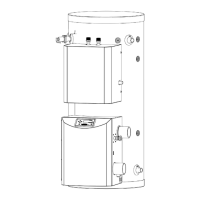LP-314 Rev. 012 Rel. 003 Date 9.27.19
4
D. Auxiliary Connections 14
E. Temperature and Pressure Relief Valve for DHW 14
F. Backow Preventer 14
G. Potable Expansion Tank 14
H. Hydronic Heating Module Piping 15
I. Pressure Relief Valve for the Hydronic System 15
J. Hydronic Expansion Tank and Make-Up Water 15
K. Hydronic Heating Module System Piping 15
L. Hydronic Heating Module Output 15
M. Applications 18
N. Filling the Appliance 20
Part 5 - Venting 20
A. General 20
B. Approved Materials for Exhaust Vent and Intake Pipe 21
C. Additional Requirements for Installation in Canada 21
D. Exhaust Vent and Intake Pipe Location 22
E. Exhaust Vent and Intake Pipe Sizing 23
F. Longer Vent Runs 23
G. Exhaust Vent and Intake Pipe Installation 23
H. Applications 24
1. Direct Vent Installation of Exhaust and Intake 24
2. Venting Through an Existing System 26
3. Power Venting, Indoor Combustion Air in Conned or Unconned
Space 27
Part 6 - Condensate Removal 29
Part 7 - Wiring 29
A. Field Wiring 29
B. Line Voltage Wiring 29
C. Low Voltage Wiring 29
D. Alarm Connections 30
E. Optional 0-10 Volt Building Control Signal 30
F. Customer Connection Board 31
G. Internal Wiring Diagram 32
Part 8 - Gas Connections 34
A. Gas Pipe Sizing Tables 34
1. Gas Pipe Sizing 34
2. Natural Gas Pipe Sizing 34
3. LP (Liquid Propane) Gas Pipe Sizing 35
B. Gas Piping Requirements 35
C. Gas Valve 35
D. Checking Gas Pressure at the Appliance for Proper Operation
36
Part 9 - Start-Up Preparation 36
A. Fill and Purge DHW 36
B. Fill and Purge Hydronic Heating Loop 36
C. Purge Air from Hydronic Heating Module 36
D. Using the Control to Assist in Purging System Loops 37
E. Programming the Total System Control 37
Part 10 - Start-Up Procedures for the Installer 38
A. Navigation of the Display 38
B. Programming the Control 39
C. Programming the System Setting 39
D. System Setting Program Navigation 39
E. Control Status Menu 41
F. Resetting the Maintenance Schedule 42
G. Test Mode 42
Part 11 - Troubleshooting 42
A. Error and Fault Codes 42
B. Appliance Error 42
C. Appliance Fault 42
D. User Interface Display 43
Part 12 - Maintenance 46
Part 13 - Shutdown 47
A. Shutdown Procedure 47
B. Vacation Procedure 47
C. Failure to Operate 47
D. Important Notice 47
Table of Contents
Part 1 - General Safety Information 5
A. Improper Combustion 5
B. Gas 5
C. When Servicing the Appliance 5
D. Appliance Water 5
E. Freeze Protection 5
F. High Elevation Installations 6
G. Water Temperature Adjustment 6
Part 2 - Before You Start 6
A. What’s in the Box 6
B. How the Appliance Operates 6
C. Optional Equipment 7
Part 3 - Prepare the Appliance 7
A. Locating the Appliance 7
B. Leveling 8
C. Clearances for Service Access 8
D. Residential Garage and Closet Installations 8
E. Exhaust Vent and Intake Pipe 8
1. Direct Vent of Exhaust and Intake 9
2. Power Venting, Indoor Combustion Air in Conned or Unconned Space
9
F. Carbon Monoxide Detectors 9
G. Prevent Combustion Air Contamination 9
H. Removing an Appliance from a Common Vent System 10
I. Water Chemistry Requirements 10
Part 4 - Domestic Hot Water and Hydronic Piping 12
A. Plumbing 12
1. System Domestic Water Piping 12
2. Appliance Domestic Water Piping 12
B. Scalding 12
C. Mixing Valve Installation 13
From the Uniform Plumbing Code 2000 - Section 510 -
Protection From Damage
1. Appliances generating a glow, spark or ame capable of igniting
ammable vapors may be installed in a garage, provided the pilots,
burners or heating elements and switches are at least eighteen (18)
inches (457 mm) above the oor level.
2. Where such appliances installed within a garage are enclosed
in a separate, approved compartment having access only from
outside of the garage, such appliances may be installed at oor level
provided the required combustion air is also taken from the exterior
of the garage. Fuel burning appliances having sealed combustion
chambers need not be elevated.
3. All appliances installed in areas where they may be subjected to
mechanical damage shall be suitably guarded against such damage
by being installed behind adequate barriers or by being elevated or
located out of the normal path of a vehicle using any such garage.
4. In seismic zones 3 and 4, appliances shall be anchored or strapped
to resist horizontal displacement due to earthquake motion.
Strapping shall be at points within the upper one-third (1/3) and
lower one-third (1/3) of its vertical dimensions. At the lower point, a
minimum distance of four (4) inches (102 mm) shall be maintained
above the controls with the strapping.
5. An appliance supported from the ground shall rest on level
concrete or other approved base extending not less than three (3)
inches (76 mm) above the adjoining ground level.
6. When an appliance is located in an attic, attic-ceiling assembly,
oor-ceiling assembly, or oor-suboor assembly where damage
may result from a leaking appliance, a watertight pan of corrosion
resistant materials shall be installed beneath the appliance with
a minimum three-quarter (3/4) inch (20 mm) diameter drain to an
approved location.

